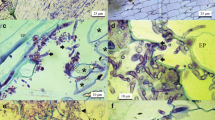Abstract
Auto- and alloplasmic doubled haploid (DH) lines of barley were examined for susceptibility to Fusarium culmorum (W.G.Sm.) Sacc. (isolate KF350) seedling blight. Inoculated kernels were incubated at 20 °C in a chamber saturated to 100% RH a with 12/12 h dark/light cycle. Germination capacity, disease score on a 5-degree scale and root length were evaluated. The data were analysed statistically using three-factor analysis of variance. It was observed that the infection score of roots of DH lines with H. bulbosum cytoplasm was higher than that of their autoplasmic analogues. Length of infected seedling roots expressed as per cent of the control root length ranged from 81 to 56% in autoplasmic DH lines and from 60 to 48% in alloplasmic lines. These differences were statistically significant (at P = 0.01). It was evident, that H. bulbosum cytoplasm increase susceptibility of barley genotypes to Fusarium seedling blight.
Similar content being viewed by others
References
Adamski, T., 1979. The obtaining of autodiploid barley lines using haploids from the cross Hordeum vulgare L. × Hordeum bulbosum. Genet Pol 20: 31–42.
Adamski, T. & M. Surma, 1994. The influence of genotypes on production of barley haploids with Hordeum bulbosum cytoplasm. Genet Pol 35: 241–248.
Aida, Y., M, Muramatsu, T. Fukui & S. Tsubuko, 1981. Malting quality of barley cultivar with Hordeum bulbosum cytoplasm. Bul Brewing Sci 27: 17–21.
Devaux, P., 1986. Yield of haploid production through the bulbosum method in a winter barley breeding programme. Cereal Res Commun 14: 273–279.
Devaux, P., T. Adamski & M. Surma, 1990. Study on low cross-abilities encountered with the Hordeum bulbosum method for haploid production of barley, Hordeum vulgare L. Plant Breed 104: 305–311.
Grey, E.W. & D.E. Mathre, 1988. Evaluation of spring barely for reaction to Fusarium culmorum seedling blight and root rot. Can J Plant Sci 68: 23–30.
Johns, W.A. & B.L. Harvey, 1974. The effects of Hordeum bulbosum cytoplasm on H. vulgare L. In: K.J. Kasha (Ed.), Haploids in Higher Plants, pp. 276–277. University of Guelph.
Kasha, K.J. & K.N. Kao, 1970. High frequency haploid production in barley (Hordeum vulgare L.). Nature 225: 874–876.
Majewska, T., T. Adamski & M. Surma, 1992. Haploids and hybrids from the cross Hordeum bulbosum (2x) × Hordeum vulgare (2x). Cereal Res Comm 20: 121–123.
Surma, M. & T. Adamski, 1995. Barely haploids from reciprocal crosses of Hordeum bulbosum (2x) and H. vulgare (2x). J Appl Genet 36: 11–16.
Xu, Jie & J.W. Snape, 1989. The resistance of Hordeum bulbosum and its hybrids with H. vulgare to common fungal pathogens. Euphytica 41: 273–276.
Author information
Authors and Affiliations
Rights and permissions
About this article
Cite this article
Adamski, T., Chełkowski, J., Kaczmarek, Z. et al. Evaluation of susceptibility of auto- and alloplasmic barley DH lines to Fusarium seedling blight. Euphytica 93, 169–172 (1997). https://doi.org/10.1023/A:1002909901866
Issue Date:
DOI: https://doi.org/10.1023/A:1002909901866




